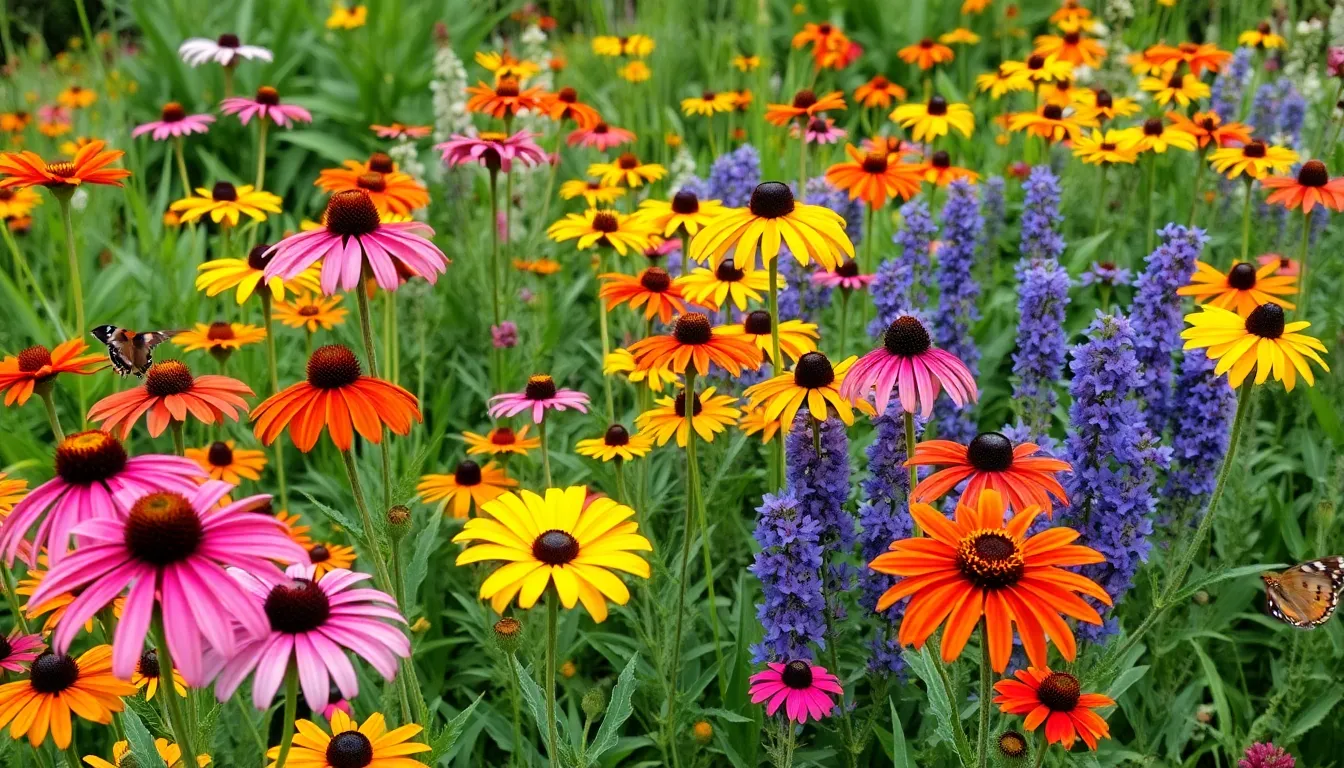Physical Address
304 North Cardinal St.
Dorchester Center, MA 02124
Physical Address
304 North Cardinal St.
Dorchester Center, MA 02124

Imagine stepping into a garden that’s not just pretty but also a local superhero for the environment. Native gardens are like the cool kids on the block—stylish, low-maintenance, and they throw the best parties for local wildlife. By incorporating plants that are naturally adapted to the region, these gardens create a vibrant ecosystem that supports birds, butterflies, and beneficial insects.
Native gardens create a harmonious connection between the environment and the ecosystem. Utilizing local flora, these gardens sustain wildlife while providing beauty and low maintenance options.
A native garden consists primarily of plants indigenous to a specific region. Native species thrive in their local climate, soil, and moisture conditions. Planting these species minimizes the need for irrigation and fertilizers. Butterfly bushes, coneflowers, and black-eyed Susans exemplify common native plants. These gardens aim to restore natural landscapes and foster biodiversity.
Native plants offer numerous ecological benefits. They provide food and habitat for local wildlife, including birds, butterflies, and beneficial insects. Pollinators such as bees rely on these plants for sustenance. Additionally, native plants establish deeper root systems, improving soil health and reducing erosion. Choosing native flora enhances resilience against pests and diseases. Resource efficiency stems from their ability to adapt to local climatic conditions, making them ideal for sustainable gardening practices.

Native gardens offer numerous benefits, ranging from ecological advantages to visual appeal. They create a sustainable environment that promotes biodiversity while enhancing the beauty of outdoor spaces.
Native gardens support local ecosystems. They provide food and shelter for wildlife, including birds, butterflies, and beneficial insects. Local flora grows well in regional climates, reducing the need for irrigation. These plants improve soil health and prevent erosion by establishing strong root systems. Gardens filled with native species also enhance resilience against pests and diseases. The use of natural plants eliminates the reliance on synthetic fertilizers and pesticides, creating a healthier environment.
The visual beauty of a native garden captivates the eye. Colorful flowers like coneflowers and black-eyed Susans bloom in various seasons, adding vibrancy. Textures and forms of native plants create an interesting landscape, leading to diverse garden designs. These gardens seamlessly blend with the surrounding environment, giving a sense of place. Native gardens invite people to connect with nature, enriching outdoor experiences. Landscapes filled with native species often require less maintenance, freeing up time for enjoyment rather than upkeep.
Creating a native garden begins with understanding local flora. Selecting the right plants and designing the space effectively ensures a thriving ecosystem.
Native plants excel in local conditions, requiring less maintenance. Identify species that attract wildlife, such as hummingbirds and beneficial insects. Research local sources or native plant nurseries for diverse options. Consider factors like sunlight and soil type when selecting plants. Popular choices include butterfly bushes, coneflowers, and black-eyed Susans. Grouping plants based on growth habits fosters natural arrangements and reduces competition for resources. Establishing a relationship with local gardeners or horticulturists provides valuable insights into enduring selections suited for regional challenges.
Effective design layout enhances the aesthetic appeal of a native garden. Start by mapping the garden space, considering sun and shade patterns throughout the day. Incorporating layers adds depth, placing taller plants at the back and shorter ones at the front. Pathways can guide visitors while showcasing the beauty of diverse flora. Including areas for relaxation, like seating or meditation spots, invites enjoyment and connection to nature. Utilizing natural materials, such as stones and wood, creates a cohesive environment. Planning for seasonal bloom ensures diverse color and interest throughout the year.
Maintaining a native garden is straightforward and rewarding. It’s essential to focus on two main aspects: watering and pest management.
Watering practices for native gardens differ from traditional gardens. Local plants typically require less water due to their adaptation to local climates. During their establishment phase, they may need regular watering. Once established, many native plants thrive on natural rainfall. It’s beneficial to assess soil moisture before watering. Deep watering promotes strong root systems, enhancing drought resistance. Rain barrels can help collect rainwater for sustainable irrigation. Consider using mulch to retain soil moisture and suppress weeds. Observing plant health can indicate when additional water is necessary.
Pest management in native gardens relies on nurturing a balanced ecosystem. Native plants naturally attract beneficial insects that help control pest populations. Encouraging predators, such as ladybugs and lacewings, can reduce harmful insects. Regular monitoring allows for early detection of pest issues. Handpicking pests like caterpillars can be an effective method. It’s vital to avoid chemical pesticides, as they can harm beneficial wildlife. Integrating companion planting can also deter pests naturally. Promoting biodiversity creates a resilient garden environment, minimizing pest outbreaks.
Embracing a native garden offers a unique opportunity to nurture the environment while enhancing outdoor aesthetics. By selecting plants that thrive in local conditions, gardeners can create a vibrant space that supports wildlife and promotes biodiversity. The low-maintenance nature of these gardens allows for more time spent enjoying the beauty they provide.
Incorporating native flora not only enriches the landscape but also fosters a deeper connection with the surrounding ecosystem. As more people turn to sustainable gardening practices, native gardens stand out as an ideal choice for those looking to make a positive impact on their local environment.